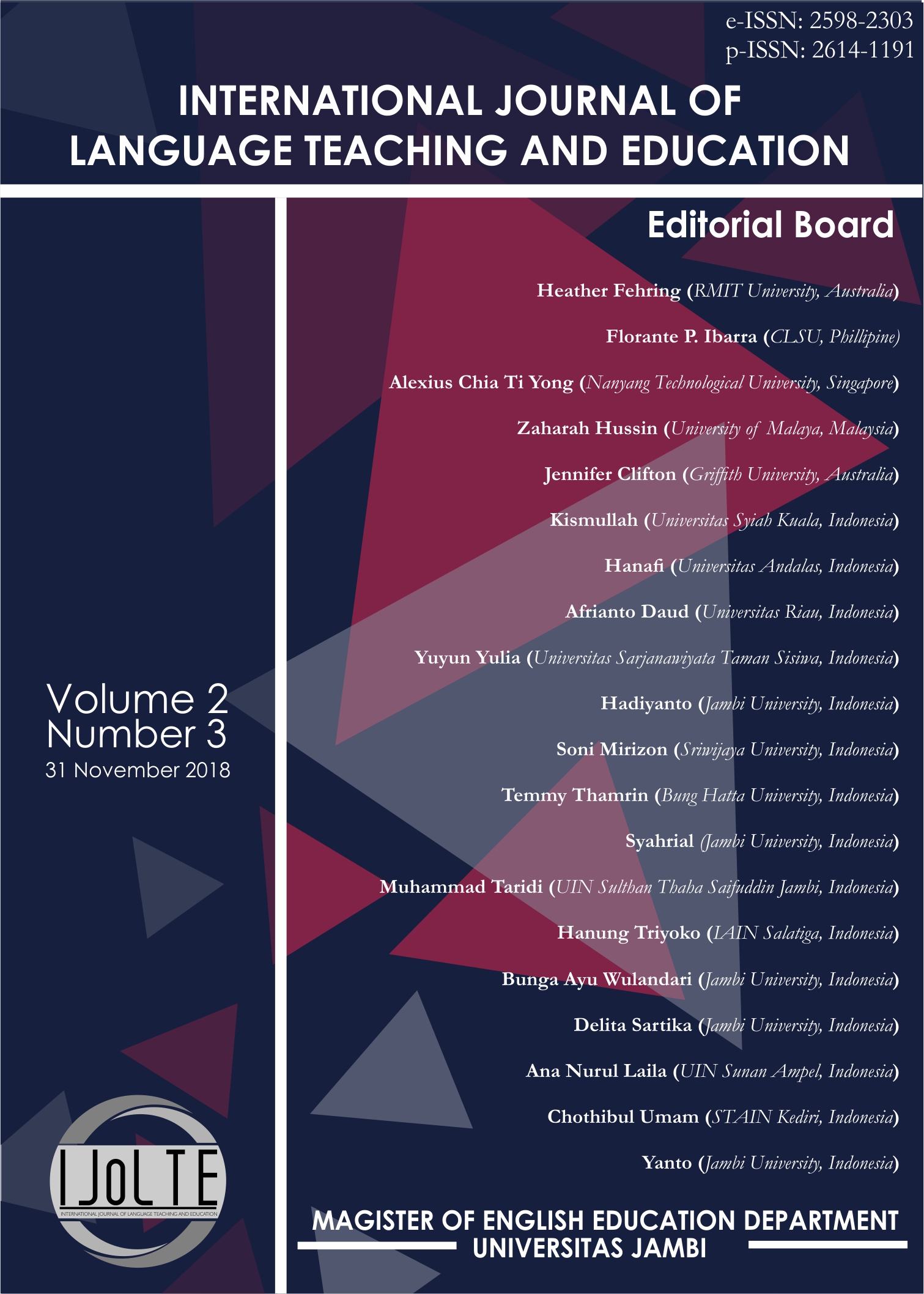From Teaching of Sundanese’s Teenager Speaking Ability In Batam: Spoken Discourse Analysis
Teaching of Sundanese’s Teenager Speaking Ability in Spoken Discourse Analysis
DOI:
https://doi.org/10.22437/ijolte.v2i3.5182Keywords:
Discourse, Sundane, Sundanese, Spoken, TeenagerAbstract
The local language is a language that used as a characteristic of the tribe or certain people and spoken in a region within a nation. It is used as a communications tool in everyday life of the tribes who lived either on a small area, province or a wider area. The existence of local language is closely related to the existence of tribes and culture which is generated from one generation to another. Sundanese language is one of the thousands of languages that exist in Indonesia, which is become the main supporting elements of the traditions and customs of the Sundanese tribe itself. Sundanese language speaking ability is one of the important aspects in terms of preservation of Sundanese culture. By using Sundanese language in daily conversation in the family, by then it is rooted in the way of life and habits of children in the Sundanese family, in order to maintain love their ancestor language. But some Sundanese families in Batam, including the teenager, think that the Sundanese language is not necessary to be learned at this era. Some of the reasons were that because it is not been taught in school, neither a prime requirement in entering college and not considered as a priority language in entering job field, which is in demand of a foreign language beside the Indonesian language. Therefore, it slowly will disappear from the Sundanese people itself. Through her observation, she found only a few families are aware of the importance of maintaining Sundanese as prime cultural characteristic. The observations to the 11 (eleventh) teenagers have shown that only 24 % categorized has the ability in speaking Sundanese language.
Downloads
References
[2] Ekadjati, (2014). Kebudayaan sunda. Bandung: PT Dunia Pustaka Jaya.
[3] Handayani, Dhona, N., & Silitong F. (2017). EFL students’ ability to identify singular and plural nouns in paragraph. ELLITE: Journal of English Language, Literature, and Teaching.
[4] Hewings, (2013). Advance grammar in use. Italy: Cambridge Univer-sity press.
[5] Koenig, M. (2002). The impact of government policies on territorially based ethnic or nationalist movements. International Journal on Mul-ticultural Societies, 4(2).
[6] Mainizar, (2013). Marwah: Peranan orang tua dalam pembinaan dan pengembangan bahasa pada anak usia 2-6 tahun. 12(1)
[7] Mulyati at all (2014), Bahasa Indonesia, Tangerang: Universitas ter-buka.
[8] Richards, J. C., Rodgers, T. S. (2011). Approaches and methods in language teaching (2nd ed.). United States of America: Cambridge University Press.
[9] Sallabank, J. (2010). Language endangerment: Problems and solutions. 50-87
[10] Saputra, S. (2007). Webster’s kamus lengkap Inggris-Indonesia, Indo-nesia- Inggris. Batam: Karisma Publishing Group.
[11] Silitonga, F. (2017). The Teenegers’ characteristics in gender written text by discourse analysis at Batam. Kajian Linguistik dan Sastra, 61-75.
[12] Silitonga, Oktavia F. Y. (2017). Implementasi analisis wacana kritis perspektif Leeuwen dalam berita politik surat kabar Padang ekspres terhadap pembelajaran bahasa berbasis teks.
[13] Sugiyono, (2011). Metode penelitian kuantitatif, kualitatif dan R&D. Bandung: ALFA BETA.
[14] Wibisana, (2011). Ngamumule basa sunda. Bandung: PT. Kiblat Utama.
[15] Yule, (2010). The study of language. New York: Cambridge Univer-sity Press.
Downloads
Published
Versions
- 2018-12-01 (1)
- 2018-12-01 (1)
How to Cite
Issue
Section
License
The Authors submitting a manuscript do so on the understanding that if accepted for publication, copyright of the article shall be assigned to International Journal of Language Teaching and Education (IJoLTe) and Magister Program of English Education Department, Universitas Jambi as publisher of the journal. Copyright encompasses rights to reproduce and deliver the article in all form and media, including reprints, photographs, microfilms, and any other similar reproductions, as well as translations.
IJoLTe keep the rights to articles that have been published. And, the authors are permitted to disseminate published article by sharing the link of IJoLTe' website. Authors are allowed to use their works for any purposes deemed necessary without written permission from IJoLTe with an acknowledgement of initial publication in this journal.
IJoLTe and Magister Program of English Education Department, Universitas Jambi, and the Editors make every effort to ensure that no wrong or misleading data, opinions or statements be published in the journal. In any way, the contents of the articles and advertisements published in IJoLTe are the sole and responsibility of their respective authors and advertisers.
If the article was jointly prepared by more than one author, any authors who submitting the manuscript warrants that he/she has been authorized by all co-authors to be agreed on this copyright and license notice (agreement) on their behalf, and agrees to inform his/her co-authors of the terms of this policy. IJoLTe will not be held liable for anything that may arise due to the author(s) internal dispute. IJoLTe will only communicate with the corresponding author.
By submitting the article/manuscript to this journal, the authors agree with this policy and consciously agree that IJoLTe does not provide royalties or other fees to the authors for their published articles. By agreeing this policy, IJoLTe ensures that published articles are publicly accessible and will be free of charge for the readers. No specific document sign-off is required.
Users of this website will be licensed to use materials from this website following the Creative Commons Attribution 4.0 International License. Please use the materials accordingly
You are free to:
- Share — copy and redistribute the material in any medium or format
- Adapt — remix, transform, and build upon the material for any purpose, even commercially.
- The licensor cannot revoke these freedoms as long as you follow the license terms.








1.png)
